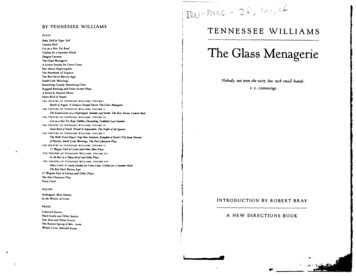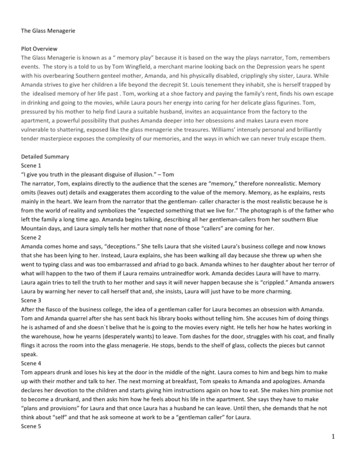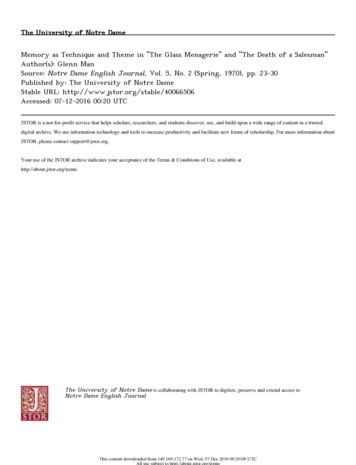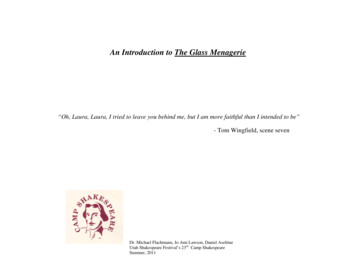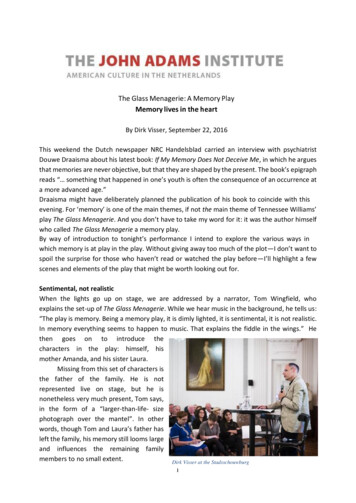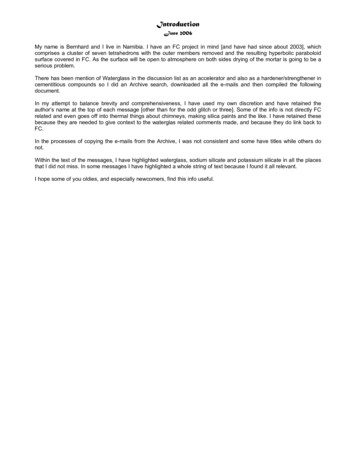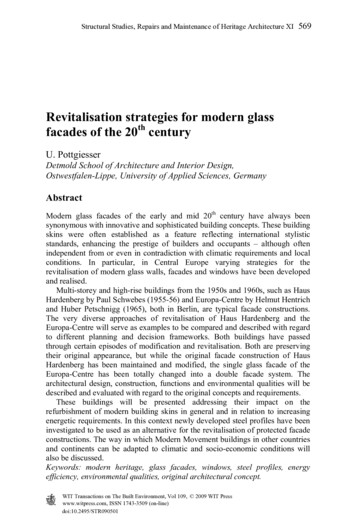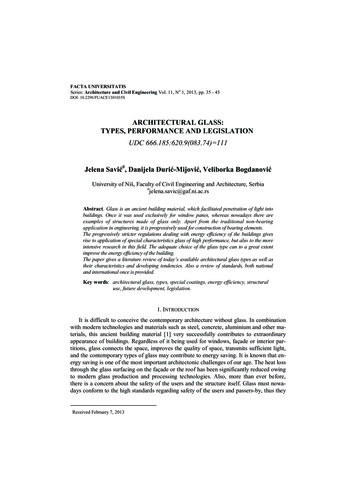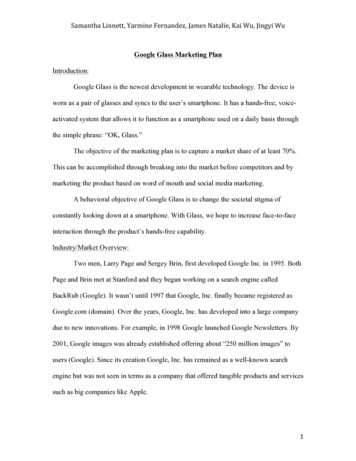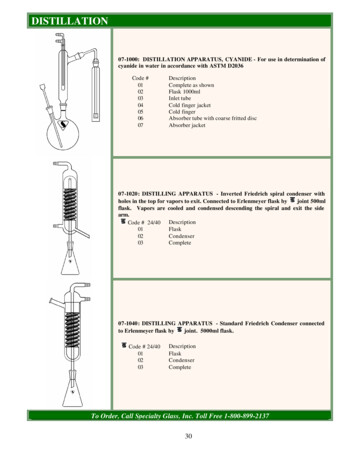
Transcription
SamplePrestwick HouseMultiple CriticalPerspectives Prestwick HouseTeaching Tennessee Williams’sThe Glass MenageriefromMultiple Critical Perspectives Click hereto learn moreabout thisMultiple CriticalPerspectives! Click hereto find moreClassroom Resourcesfor this title! Prestwick HouseMore from Prestwick HouseLiteratureLiterary Touchstone ClassicsLiterature Teaching UnitsGrammar and WritingCollege and Career Readiness: WritingGrammar for WritingVocabularyVocabulary Power PlusVocabulary from Latin and Greek RootsReadingReading Informational TextsReading Literature
Multiple CriticalPerspectivesTeaching Tennessee Williams'sThe Glass MenageriefromMultiple Critical Perspectives byElizabeth Osborne
Multiple CriticalPerspectivesThe Glass MenagerieGeneral Introduction to the WorkIntroduction to The Glass MenagerieTheGlass Menageriepremiered inChicago in 1944 and in New York in 1945. It was an immediatecritical success, winning a New York Drama Circle award and establishing its creator as an importantplaywright.Tennessee Williams (1911 – 1983) drew upon his own life for some of the details in The Glass Menagerie(which was actually a reworking of an earlier short story called “Portrait of a Girl in Glass”). Williams had asister, Rose, who was mentally troubled and eventually underwent a lobotomy. The procedure destroyed hermind. The difference between sensitive people who thrive and sensitive people who do not, Williams cameto believe, comes down to whether a person can use art to cope with his or her pain.Art as a tool for controlling and reshaping mental pain is therefore an important theme in The GlassMenagerie. The protagonist and narrator, Tom Wingfield, is a would-be poet who works in a shoe factoryto support his mother and sister; books and writing are his only way to avoid insanity. His battles with hismother over how he uses his mind and spends his life eventually compel him to run away.Also important to The Glass Menagerie are the historical and social details of life in the late 1930s.The play is set in 1937 in St. Louis, Missouri; the events that will soon cause World War II are occurring,but people in St. Louis are mostly unaware of them.Of course, Williams, who wrote “Portrait of a Girl in Glass” in the early 1940s, then reworked thematerial into The Glass Menagerie soon afterwards, knew about the war. The characters’ “matriculation ina school for the blind” is a deliberate device on his part. Only Tom, who is both narrator and character,living in the present and the past, is aware of what will happen.The Glass Menagerie was an early example of a new kind of play—one that examined psychologicalpatterns and family relationships through impressionistic, sometimes stream-of-consciousness,presentation. In fact, Williams calls The Glass Menagerie a “memory play” because of its dramaticpresentation of the memories and impressions of the protagonist, Tom. Just as in memories, some detailsare exaggerated and some are left out. Arthur Miller’s Death of a Salesman (1949) would take a similarapproach.The Glass Menagerie was adapted for film and television several times; one of the most popular is a1973 version with Katherine Hepburn and Sam Waterston. High schools and small repertory theaters alsochoose to stage the play because it requires only a single, interior set; minimal props; and few actors.6Pr e s t w i c kHo u s e,In c.
The Glass MenagerieMultiple CriticalPerspectivesPsychoanalytic TheoryApplied to The Glass MenagerieNotes on the Psychoanalytic TheoryThe term“psychological” (also “psychoanalytical” or “FreudianTheory”) seems to encompass two almost contradictory criticaltheories. The first focuses on the text itself, with no regard to outsideinfluences; the second focuses on the author of the text.According to the first view, reading and interpretation are limitedto the work itself. One will understand the work by examiningconflicts, characters, dream sequences, and symbols. In this way, thepsychoanalytic theory of literature is similar to the Formalist approach.One will further understand that a character’s outward behavior mightconflict with inner desires, or might reflect as-yet-undiscovered innerdesires.Main areas of study/points of criticism of the first view: There are strong Oedipal connotations in this theory: the son’sdesire for his mother, the father’s envy of the son and rivalryfor the mother’s attention, the daughter’s desire for her father,the mother’s envy of the daughter and rivalry for the father’sattention. Of course, these all operate on a subconscious level toavoid breaking a serious social more. There is an emphasis on the meaning of dreams. This is becausepsychoanalytic theory asserts that it is in dreams that a person’ssubconscious desires are revealed. What a person cannot expressor do because of social rules will be expressed and accomplishedin dreams, where there are no social rules. Most of the time,people are not even aware what it is they secretly desire untiltheir subconscious goes unchecked in sleep.Pr e s t w i c kHo u s e,In c.13
The Glass MenagerieMultiple CriticalPerspectivesActivity OneConsidering Oedipal Aspects of The Glass Menagerie1.Copy and distribute the handout: Oedipal Aspects of The Glass Menagerie.2.As a class, review the information in “Notes on Psychoanalytic Theory.”3. Have students work in pairs or individually. Each pair or individual will answer the questions on thehandout.4.Reconvene the class and use the following questions to start a class discussion: What role does Jim play in the Oedipal structure of the play? Discuss his relationship to each of the Wingfields, including Mr. Wingfield.Pr e s t w i c kHo u s e,In c.17
The Glass MenagerieMultiple CriticalPerspectivesFeminist Criticism Appliedto The Glass MenagerieNotes on the Feminist TheoryFeminism is an evolving philosophy,and its application in literatureis a relatively new area of study. The basis of the movement, bothin literature and society, is that the Western world is fundamentallypatriarchal (i.e., created by men, ruled by men, viewed through the eyesof men, and judged by men).In the 1960s, the feminist movement began to form a new approachto literary criticism. Of course, women had already been writing andpublishing for centuries, but the 1960s saw the rise of a feminist literarytheory. Until then, the works of female writers (or works about females)were examined by the same standards as those by male writers (andabout men). Women were thought to be less intelligent than men, at leastin part because they generally received less formal education, and manywomen accepted that judgment. It was not until the feminist movementwas well under way that women began examining old texts, reevaluatingthe portrayal of women in literature, and writing new works to fit thedeveloping concept of the “modern woman.”The feminist approach is based on finding and exposing suggestionsof misogyny (negative attitudes toward women) in literature. Feministsare interested in exposing the undervaluing of women in literature thathas long been accepted as the norm by both men and women. Theyhave even dissected many words in Western languages that reflect apatriarchal worldview. Arguing that the past millennia in the Westhave been dominated by men—whether the politicians in power or thehistorians recording it all—feminist critics believe that Western literaturereflects a masculine bias, and, consequently, represents an inaccurate andpotentially harmful image of women. In order to repair this image andachieve balance, they insist that works by and about women be added tothe literary canon and read from a feminist perspective.Pr e s t w i c kHo u s e,In c.29
The Glass MenagerieMultiple CriticalPerspectivesActivity OneComparing Views of Love, Courtship, and Marriage in The Glass Menagerie1.Copy and distribute the handout: Examining Love, Courtship, and Marriage in The Glass Menagerie.2.Divide the class into four groups or a number divisible by four.3.Assign to each group, or allow each to choose, one of the characters in The Glass Menagerie: Tom Amanda Laura Jim4. Have each group discuss its character’s scenes and then provide the requested information in thechart.5.Reconvene the class and have each group present its findings.6. As a class, compose possible one-sentence thesis statements that express the play’s assumptions aboutthe role of the woman in love, courtship, and marriage in The Glass Menagerie.NOTE: Students do not need to agree, or even come to consensus. Your class may draft as many potential thesisstatements as occur to the class.NOTE: As an additional activity, you may want to assign one or more of these thesis statements as a writingassignment.Pr e s t w i c kHo u s e,In c.33
The Glass MenagerieMultiple CriticalPerspectivesMarxist Approach Appliedto The Glass MenagerieNotes on the Marxist ApproachTheMarxistapproach to literatureis based on the philosophyof Karl Marx, a German philosopher and economist. His majorargument was that whoever controlled the means of production insociety controlled the society—whoever owned the factories “owned”the culture. This idea is called “dialectical materialism,” and Marx feltthat the history of the world was leading toward a communist society.From his point of view, the means of production (i.e., the basis ofpower in society) would be placed in the hands of the masses, whoactually operated them, not in the hands of those few who ownedthem. It was a perverted version of this philosophy that was at theheart of the Soviet Union. Marxism was also the rallying cry of thepoor and oppressed all over the world.To read a work from a Marxist perspective, one must understandthat Marxism asserts that literature is a reflection of culture, and thatculture can be affected by literature (Marxists believed literature couldinstigate revolution). Marxism is linked to Freudian theory by itsconcentration on the subconscious—Freud dealt with the individualsubconscious, while Marx dealt with the political subconscious. Marxbelieved that oppression exists in the political subconscious of asociety—social pecking orders are inherent to any group of people.Four main areas of study: economic power materialism versus spirituality class conflict art, literature, and ideologiesPr e s t w i c kHo u s e,In c.41
The Glass MenagerieMultiple CriticalPerspectivesActivity OneAnalyzing the Importance of Labor and Capital in The Glass Menagerie1.Copy and distribute the handout: Historical Background of The Glass Menagerie.2.As a class, reexamine the section of the Marxist approach on the importance of labor.3.Divide the class into four groups or a number of groups divisible by four.4.Assign to each group, or allow each to choose, one of the following topics: Guernica/Spanish Civil War Labor Unrest in the United States The Great Depression World War II5.Reconvene the class and have each group report its findings to the class.6.As a class, discuss the following questions: Beyond merely establishing “atmosphere” and background, why do you suppose Williams set hisplay against such a turbulent backdrop? (Remember the play is set in 1937, but it was written in1943 – 1944.) What does the background have to do with the lives of the characters? What does the background contribute to the plot? What does the background contribute to the overall theme or meaning of the play? In establishing the backdrop, why does he choose specifically the events and movements he does? Does Williams seem to take a Marxist view of history? If so, what other evidence of this view canyou find in the play?Pr e s t w i c kHo u s e,In c.45
The Glass Menagerie was an early example of a new kind of play—one that examined psychological patterns and family relationships through impressionistic, sometimes stream-of-consciousness, presentation. In fact, Williams calls The Glass Menagerie a “memory play” because of its dramatic presentation of the memories and impressions of the protagonist, Tom. Just as in memories, some File Size: 1MBPage Count: 9People also search forglass menagerie analysis scholarlythe glass menagerie amanda analysisthe glass menagerie setting analysisthe glass menagerie tom analysis
